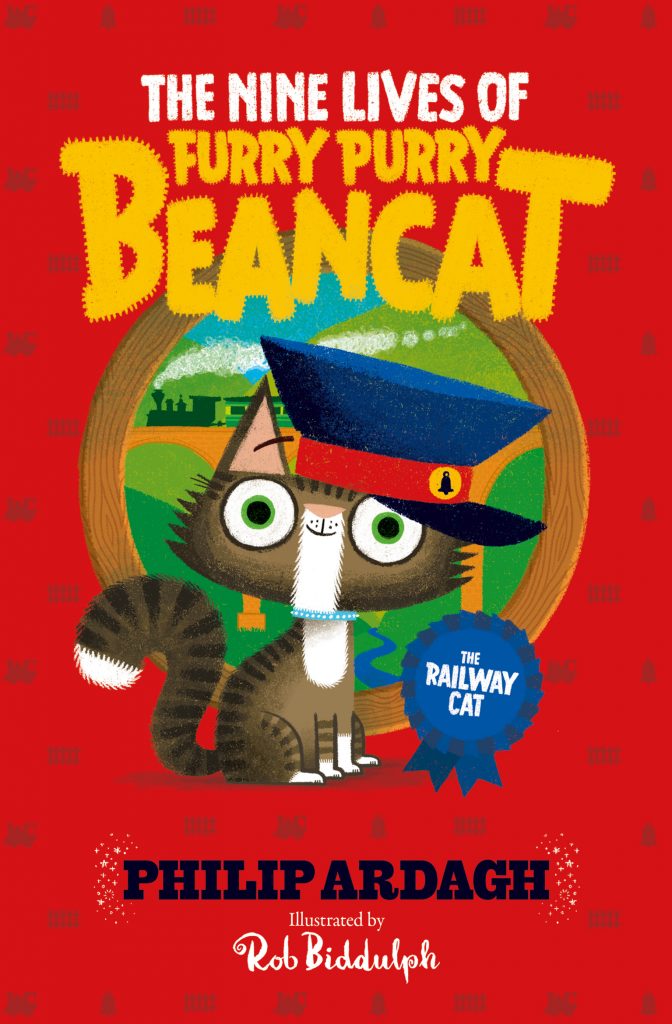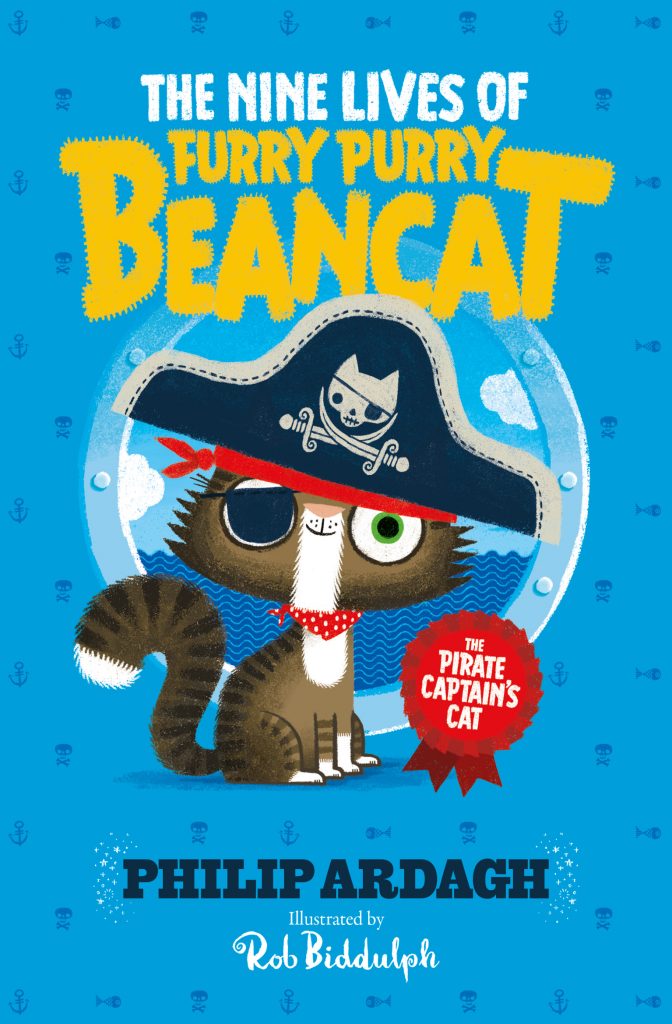Today is the publication day for two new books in the ‘The Nine Lives of Furry Purry Beancat’ series called THE PIRATE CAPTAIN’S CAT and THE RAILWAY CAT. Both books are illustrated by Rob Biddulph and written by Philip Ardagh. To celebrate their release, Philip joins us today in #TheRealm to talk about his favourite cat facts!

I’ve always loved moggies but never got to share a house with one until Beany — also known as Furry Purry Beancat — came to live me. She was a kitten when she moved in, but I was already an adult. When she was tiny, she would sometimes run up the back of my trouser legs and then pause to get a better view of the kitchen surfaces. This was fine until, one day, she did it when I was wearing shorts, not trousers.
Ooo! Ahh! Arrrgh! Ouch! My legs! My legs!

Here are my Top Ten Favourite Cat Facts:
1. NOW EVERYONE NOSE
Cats are born with their eyes closed so, as teeny-weeny kittens, they get to know the world around them with their noses. They don’t just use them to smell with but for touch, too. Later in life, cats use a nose-to-nose touch to be friendly with other cats they like and, if you’re lucky enough, maybe even you. Scientists now think that a cat’s nose pad is as individual as a human’s fingerprint.
2. GIVE ME A BELL
There’s an Aesop’s Fable about a bunch of mice fed up with a cat who’s making their lives VERY difficult. One mouse suggests that they put a bell on the cat so they’ll hear it coming and can hide. They all get VERY excited about the idea until one of them asks, “Who will put the bell on the cat?” Good question! There’s actually a phrase ‘belling the cat’ for solutions which SOUND good but can’t actually be put into practice!
3. GETTING THE BLUES
Most cats are born with blue eyes but, between twelve weeks and six months, they become the colour they’ll remain. They may turn green or amber, for example, or just stay blue. White cats with blue eyes are normally deaf. If they have one blue eye and one eye a different colour – which they often do – only the ear on the side of the blue eye is usually deaf. Isn’t that amazing?
4. CHARGING YOUR KINDLE
You probably know that the collective nouns for quite a few animals: a pride of lions, a school of dolphins, a murder — yes murder — of crows, for example, but did you know that a group of domestic cats is called a clowder? Well, you do now. What’s more, a group of KITTENS is a kindle… not to be confused with the e-reader. (As if you would be.)
5. GETTING IN A (CAT) FLAP!
Sir Isaac Newton, famous for discovering gravity, also did experiments with light, shining sunlight through a prism. He did lots of experiments in a specially darkened room but these were often ruined when his cat — whom he adored — would push the door open to get out, letting in the light. Newton solved this by cutting a hole in the bottom of the door, with a piece of felt attached to the top, for her to go in and out of. Clever though Newton was, when his cat had kittens, he cut little doors for them too. It didn’t occur to him that they could all use the same cat-flap!

6. WHAT THE DIKIN?
There is a Victoria Cross for animals. It is called the PDSA Dickin Medal and was originally created to honour the work of animals in World War II. Made of bronze, it bears the words “For Gallantry” and “We Also Serve” within a laurel wreath. A number of dogs, horses and pigeons have received the award but, so far, only one cat.
Simon was a ship’s cat aboard the HMS Amethyst. When the ship was attacked in 1949, twenty-five members of crew were killed and many more injured. Simon’s whiskers and eyebrows were singed off and he got shrapnel – bits of metal – in his leg. Despite this, he continued his duties as rat-catcher, was a great comfort to the injured, and a real morale-booster to all the men who saw him carry on as usual above and below decks. Simon was awarded the Dickin for “gallantry under fire” and for the disposal of many rats despite shrapnel injuries. Sadly, he died before he could be presented with the actual medal in December 1949.
7. UNIDENTIFIED CREAMY SAUCER
The White House — the official residence of the presidents of the United States — has been home to many cats over the years, and President Calvin Coolidge was a real cat lover. One day, he had a guest at a presidential breakfast who was very keen to follow all the etiquette rules of breakfasting with ‘the leader of the free world’. He would watch to see which glass Coolidge drank his orange juice from before he did the same, for example. When the president filled a saucer full of cream, he though he’s better copy him… only to see Coolidge put the saucer on the floor for the cat!
8. CAUGHT NAPPING
On average, a domestic cat sleeps sixteen hours a day. That’s around 70% of the time snoozing. Add to that the 15% of the time it spends grooming, and that only leaves them 15% of the time to do anything else… which is why it’s nice when they choose OUR laps to sleep on.
9. NO BONES ABOUT IT
The average cat has many, many, MANY more bones in its skeleton than the human adult’s 206. Not only that, the bones that make up their spine are more spaced than our backbones are, giving a cat more flexibility. It can curl itself up into a ball for a sleep or streeeeetch out to pounce or leap.
10. LEGGING IT!
Cats – including lions, tigers, leopards, etc. – move in a very unusual way for a four-legged animal. In fact, there are only two other types of animal which move in a similar fashion. Guess. Go on, guess. Well, the answer is camels and giraffes! Dogs use their front legs first and then their back ones but not cats. Oh, no. Cat’s use their front and back legs on one side, and then their front and back legs on the other, and so on! This is what gives them their bouncy lolloping stride.
BONUS FACT: Did you know that the average cat has five toes on each front paw and four toes on each back paw, and – in the same way that humans are usually right or left-handed rather than using both equally, around 60% of domestic cats favour one paw over the other, too.
So, there you go. Lots of fascinating feline facts. I could have written 20 or 30… but I’ve got more books to write about, you guessed it, Furry Purry Beancat, so I’d better get going.
Thanks for having me on The Reading Realm and happy reading everyone!


One Response
I loved these Top Ten Favourite Cat Facts! They’re exactly the same as my own… Hang on… No wonder, it’s because I AM Philip Ardagh! Thanks for reading my comment. (And if you DIDN’T read it, then you’re not reading this sentence in brackets either.)